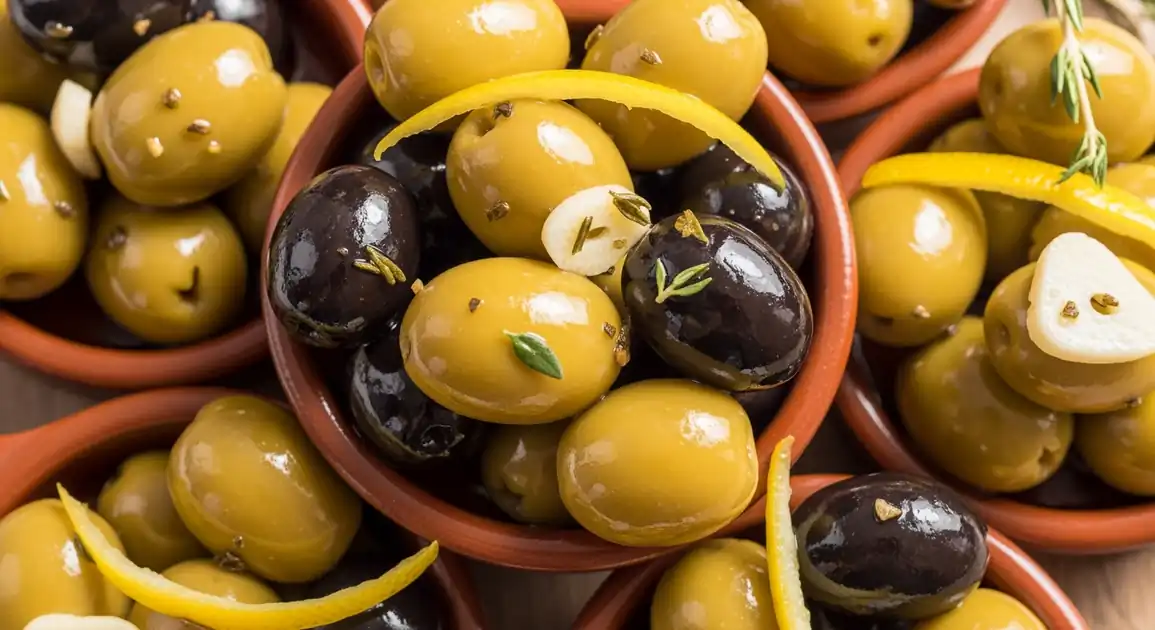Aceitunas Aliñadas (Marinated Olives)
Aceitunas Aliñadas

Description
Marinated olives are ubiquitous throughout Spain, served in nearly every bar, restaurant, and home. While universally popular, specific olive varieties and marinade styles ('aliños') exhibit strong regional character, reflecting local olive cultivation and culinary traditions.
Dietary Information
Serving information
Serving style
Served in a small bowl or dish ('platillo', 'cazuelita'), typically with pits ('con hueso'). Often accompanied by toothpicks ('palillos') or a small fork. Pits are discarded in a separate small dish if provided.
Quick facts
Bars: Generally 11 AM - late. Markets: Primarily mornings until early afternoon. Supermarkets: Standard retail hours.
Safety Tips
What to Look For
-
Plump, vibrant appearance
Indicates freshness and good quality olives. Color should be appropriate for the type.
-
Clear, clean marinade
The olive oil or brine should not look cloudy, dirty, or have scum on top.
-
Fresh, pleasant aroma
Should smell invitingly of olives, garlic, and herbs. Avoid sour, rancid, or fermented smells.
-
Reputable source
Busy bars, specialized market stalls, or trusted brands indicate better quality control and freshness.
-
Clean serving dish/container
Basic hygiene indicator for how the olives are stored and served.
What to avoid
-
Mushy or excessively soft texture
Can indicate spoilage or poor quality olives.
-
Dull color or visible mold/spots
Clear signs of spoilage; do not eat.
-
Cloudy, foamy, or dirty-looking brine/oil
Suggests contamination or that the olives have been sitting for too long improperly stored.
-
Rancid oil smell or sour/fermented odor
Indicates spoilage. Trust your senses.
-
Uncovered olives exposed to flies/dust
Especially relevant at markets or outdoor stalls. Choose covered or protected olives.
Price information
Price range
Budget tips
- Often served free ('gratis') with the first drink in many regions (less so in major tourist hubs like Barcelona).
- As a paid 'ración' (portion) in a bar, prices are usually quite affordable.
- Buying by weight in local markets offers good value.
Value indicators
- Plumpness and freshness of the olives.
- Complexity and balance of the marinade flavor.
- Quality of the olive oil used.
- Variety offered (different types/marinades).
Where to Find This Dish
Tapas Bars Nationwide
The primary venue. Almost guaranteed to be on offer.
Any bar with a 'tapas' sign
Lunchtime, Evening
Local Markets ('Mercados')
Stalls specializing in olives ('encurtidos' or 'aceitunas') offer vast selections by weight.
Mercado Central (Valencia), La Boqueria (Barcelona), Mercado San Miguel (Madrid)
Morning, Early Afternoon
Supermarkets ('Supermercados')
Wide range of packaged olives from different brands and regions.
Mercadona, Carrefour, El Corte Inglés
Retail hours
Vendor Tips
- Don't hesitate to ask the bartender or vendor about the type of olives or marinade.
- Observe what locals are eating; regional specialties are often highlighted.
- In markets, you can often buy a mix ('variado') of different marinated olives.
How to Order
Regional Variations
-
Aliño Clásico / Tradicional
(Aliño Clásico / Tradicional)
A common baseline marinade featuring garlic, oregano, thyme, paprika, olive oil, and sometimes a touch of vinegar.
-
Aceitunas Picantes
(Aceitunas Picantes)
Marinated with whole chili peppers ('guindillas'), chili flakes, or spicy paprika for heat.
-
Aceitunas Machacadas / Partidas
(Aceitunas Machacadas / Partidas)
Olives that have been cracked or split open before marinating, allowing them to absorb more flavor. Very traditional style.
-
Manzanilla Aliñada
(Manzanilla Aliñada)
Small, crisp green Manzanilla olives marinated, often simply with garlic and herbs.
-
Gordal Aliñada
(Gordal Aliñada)
Large, fleshy green Gordal ('Queen') olives, often marinated similarly to Manzanilla, sometimes pitted and stuffed.
-
Campo Real Olives
(Aceitunas de Campo Real)
A specific type of olive from Madrid region, often greenish-brown, known for being seasoned with herbs and having a unique flavor.
-
Olives with Citrus Peel
(Aceitunas con Piel de Cítricos)
Marinades incorporating strips of lemon or orange peel for a fresh, aromatic note.
Cultural context
History
Olive cultivation has shaped the Spanish landscape and cuisine for millennia, dating back to Phoenician and Roman times. The practice of curing and marinating olives is equally ancient, developed as a preservation method and a way to enhance flavor. Regional 'aliños' (marinades) evolved based on local ingredients and traditions. The integration of olives into the tapas ritual solidified their place as an indispensable element of Spanish social eating and hospitality.
Local significance
An essential, non-negotiable part of Spanish culinary identity and social life. Symbolizes hospitality and the culture of sharing small plates (tapas).
Eating customs
- Eaten before meals to stimulate appetite.
- Shared amongst the group at the table or bar counter.